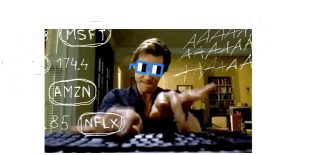Introduction to Stop Runs
What are Stop Runs?
Stop Runs are price levels where price likes to return after creating relatively equal highs. In this post I'll show you how to apply this concept and go into detail about why I think of this concept to be superior to many other retail trader patterns like the Double Tops/Bottoms.
Especially retail traders seem to think of equal highs to act like some kind of support and resistance. This is important to know as SMC traders are taking advantage of that idea to get better fills and increase their Risk/Reward Ratio.
I don't subscribe to the classic idea of support and resistance since I've seen to many equal highs being taken and traders being stopped out because of it.
So, the idea of the concept of a Stop Run is that traders place stops above old highs and below old lows. Meaning when a trader takes a long position he places his stop below an old low to protect his position. This protection is called a Sell Stop because he sells his position if price goes against him and triggers his stop loss, the other way around it would be called a Buy Stop.
However if a trader enters a short position and places a stop above an old high, he sells the underlying value (Stock, Commodity, Forex Pair, Bond,...) and places a protective Buy Stop above an old high. This means that he'll buy underlying value back at the price where his protective Buy Stop resides.
Thus, a Stop Run is that price goes a bit above an old high or multiple highs to trigger those stops, which become liquidity for the big fish that need a lot of retail orders, Lots, shares, contracts, ... to get a "full" position on, after which price then expands to the opposite direction.
"Full" of course being in relative terms as this concept can be applied to any timeframe and any market.

In the picture above I drew one Double Top and one Double Bottom. When looking at the Double Top you'll see that after going below the Double Low, price went back into the trading range.
Why is that? It's not because that's the way I did the drawing but much more a reoccurring phenomenon called a Stop Run. You'll notice that Stop Runs work often when Double Tops/Bottoms fail. That is because, what Retail traders would often times count as a breakout, is just a Stop Run.
So when big institutional investors, SMC traders, algos etc sell the market above an old high/highs, retail traders see that as a breakout and buy the orders those professional traders are selling to them in order to get a short position on.
Comparison to Retail Logic
I'll explain a Retail Trader Strategy below which could have given them a signal to enter a long position where it says "SMC Short Entry" in red and their signal to enter a short where it says "Retail Short Entry".
Let's look at a common retail trader pattern for a second, the Double Top:
It's commonly used as a sell signal after the market created 2 relatively equal highs (the more equal, the better).
The height between the low and the two highs is projected down to create a target.

Now, why do I believe Stop Runs to be superior to Double Tops? At least in most cases. For sure there's arguments for Double Tops/Bottoms where Double Tops can work better, but I believe that to be rarely the case and you also gotta account for how well one concept can be incorporated with other concepts to create a strategy with desirable Risk Reward Ratio and other important aspects.
The first very important aspect of why Stop Runs are superior to Double Tops is the entry price. The same can be applied vice versa to a Double Bottom.
For this argument I'll use a common retail trader strategy: Entry at the breakout of the low between the two tops of the Double Top.
Remember what I said about the SMC Entry. You can refer back to the following picture later on in the post.

As you can imagine the RRR (Risk Reward Ratio) is wildly different:

This is an example, of course real life examples can vary based on combinations with different strategies, but you get the idea.
Of course you could try to do a 1:2 RRR by halving the stop but if you go by EWT (Elliott Wave Theory) wave 2 may correct wave 1 by 99% which would trigger your stop.
Other advantages
There's more "signals" than Double Tops/Bottoms. This is because Stop Runs do not exclusively occur where there are multiple tops or bottoms but can also occur below a single high or low.
In this case the high or low used will most likely be a significant one.

If you look at the first Stop Run, it was a pretty significant one as it what the new ATH at that time. Price briefly spiked above it and went down hard.
However, if you look at the second one, it had a less significant reaction. In this case it might be fundamental factors like more adoption, more users etc. Still, this is often the case even in intraday timeframes which is why, even if you don't expect a reversal, you can still use Stop Runs to take profit as these areas are still used to trigger stops and where price can slow down, even if it continues to rally later on.
Sometimes they go to those areas, consolidate and then continue in that direction. There's many ways beyond SMC to explain this phenomenon. It's irrelevant why it is, it just matters that when paying close attention to everything outlines in this post, you'll gain a deeper understanding of how price moves.
You can also use intermediate or even short term lows but the less significant they are the more you have to refer to other strategies to justify why you believe price to go back to that level.
Most likely you'll use a Breaker FVG (Fair Value Gap) or even an Orderblock for that scenario. But I'll keep this post focused on Stop Runs. I'll also do a post where I explain how you can combine them into one applicable strategy.
Without going into detail, here's an example of an intermediate term high in combination with an OB (Orderblock) where ETH reacted beautifully at the midpoint of the OB.

Caveat
Of course there will be cases where price just rallies/collapses through an area where you would typically expect a Stop Run.
This can be because, similar to the first screenshot price has spiked above an old high/ low before and then dives deep ignoring the potential Stop Run to run to a superordinate target out of the higher time frame.
In other words, price does a Stop Run and then goes on to trend into the same direction without a reversal.
Trading Ranges
You can use Stop Runs in range bound markets to enter a short position at a premium or to enter a long position in a discount, giving you higher probability.

In the Screenshot shown above you can see the Tradingrange of BTCUSDT from Mid-March to the Beginning of November. As you might see, price dropped below an old low and then moved on to trade higher.
In many cases you'll see that price can trade to other areas of liquidity like a Double Top or a FVG coupled with a Breaker. Of course there are also other strategies which can be used to create a target, this is just to give you an example.
Most likely you'll choose a target at the premium of the trading range (when trading from the discount) or one out of the higher Timeframe (HTF).
In this case, Bitcoin rallied higher towards the old All Time High (ATH) ⬇️

Or you can use Stopruns to enter a trade in a trending market when knowing the higher timeframe target and allowing to enter the market on a limit order, because you're entering in a down candle (when price is retracing) in a upwards trending market and vice versa compared to a huge spread and a market order when price is moving up or an untriggered limit order.
This can be seen shortly after the trading range shown above, where price created multiple relatively equal lows, took the stop and then continued it's rally.

Failed Setups & Conclusion
You always have to see the whole picture and look at "failed setups" in the right context.
If there are Buy Stops above an old high, sellers are going to buy back their position at that price level. So if price runs to a higher TF target upside price movement actually gets fueled by buyers having to buy back their positions which is why oftentimes you see these volatile breakouts.
This is also one of the reasons why so many traders are trying to trade breakout strategies. It's because if you can time the market right and know when a breakout is legit, your trade runs almost immediately into your desired direction.
However, your fill oftentimes isn't as good and in most cases you're probably better of buying in a down candle and selling in an up candle. That way your limit order is more likely to get triggered and depending on the strategy you can take advantage of a bigger proportion of the move.
Please drop your feedback down below and tell me if you have any questions :)


Be the first to comment
Publish your first comment to unleash the wisdom of crowd.
